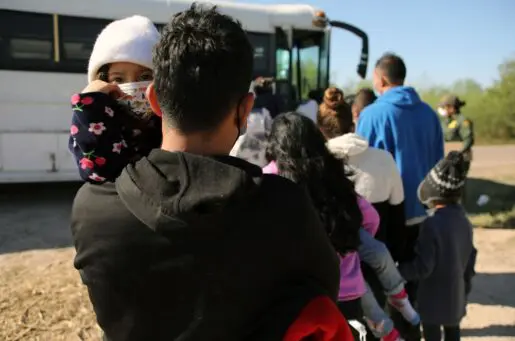Bioethics Forum Essay
Vaccine Mandates for Kids: It’s Not Whether, But When
States and school boards around the country are engaged in a debate about whether to require middle and high school students to be fully vaccinated against Covid-19. California has declared its intent to require students in kindergarten through 12th grade be vaccinated once a vaccine has received full approval for this age group by the Food and Drug Administration. Mandates from other states and school districts are likely now that the Pfizer-BioNTech vaccine is authorized for 5-to-11-year-olds.
In many ways, this is a one-sided debate. School vaccine mandates have long been part of our nation’s public health fabric. There is experience implementing and enforcing them for other vaccine-preventable diseases. School vaccine mandates have been effective in reducing the spread of diseases, as well as increasing vaccine coverage for diseases like polio, measles, and whooping cough. In addition, the health, economic, and educational impact of the current pandemic on kids all seem to converge in support of vaccine mandates for Covid.
So, what is there to debate? It is not so much about whether to mandate. It’s when to do so.
Two reasons justify restraint at this time. The first relates to our level of certainty around Covid vaccine safety. Given the lower risk of Covid-19 disease in children compared to adults, a vaccine mandate for schoolchildren will be most effective when there is a high level of certainty that the vaccine is very safe. Data collected through active surveillance (proactively obtaining health care data from individuals to identify adverse events) can help achieve this high level of certainty more reliably than can data from passive surveillance systems, like Vaccine Adverse Event Reporting Surveillance (VAERS), which rely on people reporting an event and are subject to under-reporting and reporting bias.
We might reach this level of certainty when the vaccine receives full FDA approval for a particular pediatric age group. But it can take several years from when an approved vaccine is recommended for disease prevention in children to when U.S. schools mandate the vaccine—the median time was four-to-six years, one study found. We can’t wait that long now, but we also cannot afford to be too hasty.
The collection of adverse event data after Covid vaccination through active surveillance has long been under way. The results, however, are just arriving. More analyses are needed. In stating in September that universal Covid vaccination of otherwise healthy 12-to-15-year-olds was premature, the United Kingdom’s Joint Committee on Vaccination and Immunization cited “uncertainty regarding the magnitude of the potential harms.”
The second reason is a lack of clarity surrounding the risk of school-based transmission. The rationale originally used for requiring vaccines for school attendance was the ability of this strategy to disrupt the transmission of highly infectious diseases, such as measles, between children in a setting that creates the type of close contact that can facilitate spread. School vaccine mandates remain most justifiable for vaccines that reduce school-based transmission of disease.
Before the Delta variant, school-based transmission of Covid-19 was low, particularly in states that required masks and other mitigation strategies in schools. This information was the basis for reopening schools. We need to reassess school-based transmission in the presence of the Delta variant and other variants that emerge. We also need to be prepared for the possibility that the incremental benefit of mandatory vaccination in reducing school-based transmission over and above what is being achieved by existing strategies–like vaccine mandates for school personnel, voluntary vaccination among schoolchildren, and other mitigation measures (like masks, physical distancing, and improved ventilation)–may not currently justify mandates for children. It is also not the time to relax use of these other mitigation measures in our schools given what we know about the risk of being infected with the Delta variant or transmitting it to others, even among those who are vaccinated. When that time arrives, the call for vaccine mandates for schoolchildren will be stronger.
School vaccine mandates have been a critical component of our nation’s vaccination policy for decades. It’s not a question of whether a Covid-19 vaccine should be added to the list of required vaccines for school attendance, but when to enact those mandates. That time has not yet arrived.
Douglas J. Opel MD, MPH, is an associate professor of pediatrics at the University of Washington School of Medicine and the interim director of the Treuman Katz Center for Pediatric Bioethics at Seattle Children’s Research Institute. Doug Diekema (@ddiekema1) is professor of pediatrics at the University of Washington School of Medicine and director of education at the Treuman Katz Center for Pediatric Bioethics at Seattle Children’s Research Institute, and a Hastings Center fellow. Lainie Ross (@LainieRoss) is the Carolyn and Matthew Bucksbaum Professor of Clinical Ethics and associate director of the MacLean Center for Clinical Medical Ethics at the University of Chicago, and a Hastings Center fellow.














Shouldn’t Ethicists At least Consider what other nations are doing? Where is this in the Covid discourse?
The per million rate of vaccine-associated myocarditis in the cited JCVI commentary (15-52 [how so imprecise?]) is in the same scale of magnitude as that of hospitalizations for Covid-19 and “Paediatric inflammatory multisystem syndrome temporally associated with SARS-COV2 infection (PIMS-TS)” reported as avoided by a full vaccination course: 28 PIMS-TS avoided and 93 hospitalizations avoided altogether, inclusive of Covid-19 per se.” The vaccine-associated myocarditis is characterized as “typically self-limiting and resolves within a short time,” which is not how one would characterize the alternative of SARS-CoV-2 infections and infection-associated conditions producing 93 hospitalizations of which 2+ would be to the PICU. Myocarditis is the only articulated vaccine-related issue of concern. And this concern persisting appears to be about uncertainties around “the possibility of persistence of tissue damage resulting from inflammation,” although corresponding uncertainty around the possible longterm morbidities of PIMS-TS are not identified in this balance of apprehensions at all. In it’s reported that at 6 months 39% had “minor neurological abnormalities,” 13% still had abdomenal pain, and using the PedsQL 18% by parent report and 22% by self-report had “severe emotional difficulty.”
The cited JCVI commentary also states that it was “not within its remit to incorporate in-depth considerations on wider societal impacts, including educational benefits.” But they did remark—given their mechanisms of planned delivery—that there could be interference with flu shots, and that side-effects of the vaccine could lead to a missed interval in school. With outbreaks we have seen much longer disruptions in education and damage to “educational benefits”—from the actual education, to the socialization, the food supplementation, the extra-eyes monitoring of children’s health and well-being.
While the JCVI might be unsure at this point about net vaccine benefits for otherwise healthy children, excluding educational issues, “In the latest analysis . . . estimates of the incidence of PICU admission for children aged 12 to 15 years without underlying health conditions were 2 per million, compared to over 100 per million for those with underlying health conditions.” As a public health agenda, how do most effectively get children with underlying health conditions who will clearly net benefit from being vaccinated, vaccinated? In our country where parental politics rather than factual information are expected to be hugely influential? You mandate it for all children—as the data supports that they are receiving at least some net benefit from this themselves, with the uncertainties in balance.
The argument that the masking and other measures are currently enough, but when we stop employing them then—then!—would be the time to mandate vaccines, is a preference that it’s hard to contemplate realizing. What would that look like? Sometime relaxing masking and social distancing in schools and waiting to see what rates of infection occurred, so that the argument would be taken up again at that point whether to go through a time-lengthy process to legislate/regulate, organize, and implement a vaccine mandate? And we’d need to re-procure those 28 million pediatric-sized doses. Would these be siphoned off then from the supply finally getting out to the rest of the world? It makes more sense to go through whatever period of time we will have to endure with these measures, with the lower rates of infections, transmissions, illnesses, that would occur with vaccines also having been employed—and likely sooner getting to that point of rationally reconsidering the need of these more encumbering interferences in life as we’ve known and valued it—than to consider tacking the vaccines on at “the end” (an nebulous end) of a pandemic status. Far clearer and easier having thrown the influence of vaccination already into the observed outcomes, if it proves taking the masks off isn’t feasible, to put them right back on.
Finally, vaccines do reduce the rate of infections occurring which then can be transmitted, or/and the length of time during which an infected individual is also infective. Whether this is a 5-fold reduction or a 2-fold reduction, either is significant. Apart from their own direct stake, children are potential vectors to the adult world, personal and larger world, that they depend upon for their care and well-being. In mid-October it was reported that one child loses a caregiver for every four COVID-19-related deaths in . Protracting the pandemic at all is further costing kids.
Speaking about vaccination mandates these authors provide insufficient warrant for their decided conclusion: “That time has not yet arrived.” It has.
It appears that posts remove URL citations in texts which results in some abrupt truncations. The 6 month findings for PIMS-TS were reported in the NEJM Journal Watch. The orphaning was reported by Hillis S, et al. in Pediatrics. The italics of per se was altered to a ” where there wasn’t one. I also was stating that the public health aim of getting the children with (and without) preexisting health conditions vaccinated, was feasibly only through mandating the vaccination through schools.
Though I can understands both sides of this ethical dilemma, I lean more so in favor of the requirement of middle schoolers and high schoolers to be fully vaccinated against COVID19. The reasons opposing this mandate center around theories, such as vaccine hesitancy and transmission rates according to present data. However, from an evidence-based medical approach, there are flaws within these ideas.
First, I believe it is important to mention that the Covid19 vaccines all have FDA approval, including the booster vaccinations. Most of the adverse effects that were floating around in regards to the vaccines, have been ruled out to be related to outside causes and patient co-morbidities.
Additionally, there are various other mandated vaccines required for school age children to have prior to entering the school systems/facilities, so why should this vaccine be any different? I believe that the debate amongst rate of transmission within the school setting is not as much of a valid argument against the vaccine mandate. For instance, there are numerous transmissible viruses that we are now vaccinated against, that were lethal amongst school age children. And even though the rates were not as impressive from the last school year, this does not mean that the virus will not continue to mutate, and propose serious harm to people of all ages, including those of school-age.
Much like how schools and daycares require vaccinations for other viruses, I agree—COVID-19 vaccine mandates for kids in school are coming upon approval by the FDA. However, in this debate, I think it’s also important to consider the risk of childhood transmission to vulnerable groups. Although the risk of COVID-19 disease for healthy, unvaccinated children is low, we must also consider those outwardly affected. For example, a child who possesses no prior conditions and contracts the SARS-CoV-2 virus, albeit not showing any symptoms, could transmit the virus to vulnerable classmates, teachers, or family members with medical conditions that put them at substantially high risk. Ultimately, vaccine mandates are premised on protecting the public good, even though they may limit personal liberty. While we must balance the duty to others with autonomy, when one’s self-interest infringes upon another’s safety, we must carefully consider the sacrifices to protect the beneficence of vulnerable groups, thereby upholding justice.
On the other side, an opposing consideration might look at the efficacy of rolling out a COVID-19 school vaccination mandate. Since the virus continues to mutate into new variants, it’s likely foreseeable that individuals will need the COVID-19 vaccination more frequently, much like the influenza vaccine. And this makes vaccine mandates in schools a lot more complicated. After doing some research, I found that only 7 out of 50 states require influenza vaccinations for childcare and pre-k (https://www.immunize.org/laws/flu_childcare.asp). Thus, it seems that requiring a yearly vaccination may pose some substantial logistical problems. To balance the safety of the public good, I’m curious to know how governments and schools will roll out these vaccine mandates in an efficacious manner.